Posted by
ndronen
at
3:52 PM
0
comments
![]()
Labels: photos
the blog to nowhere
The crew just finished clearing the snow from the parking lot with a Bobcat. They worked all day, some with shovels. Last night the air filled with flakes. Tonight it's fog.
Posted by
ndronen
at
6:55 PM
0
comments
![]()
Labels: photos
We've had two or so feet of snow around Denver since Wednesday morning. I took these last night right before going to sleep.
Posted by
ndronen
at
7:53 AM
0
comments
![]()
Labels: photos
As if on cue, Paul Matwychuk writes about Christopher Guest's antipathy.
Posted by
ndronen
at
6:00 AM
0
comments
![]()
Labels: movies
Early last January at the Hotel Donaldson in downtown Fargo, I promised to write something to convince a friend, John Lamb, of the reasonableness of the claim that the Coen brothers are sometimes unsympathetic to their on-screen subjects. I don't know that I can present an airtight case for the claim, but I'll kick the idea around for a while and see what happens.
I first heard the claim a few years ago at the University of Colorado, during a "Cinema Interruptus" -- a viewing of a film during which anyone in the audience can yell "stop" at any time in order to air a comment or question -- hosted by Roger Ebert. There were five sessions. On Monday we watched Fight Club from beginning to end, no interruptions. From Thursday to Friday we watched it again, interruptions allowed, for an hour or so each day. (Ebert's been doing this every year for a while. The schedule for that event isn't online, but last year's is [PDF].)
Anyway, that week Ebert mentioned that some people have criticized the Coen brothers for lacking sympathy for their characters. I think he said it during the scene in which The Narrator, Edward Norton's character, beats the blond character to a bloody pulp and justified it with, "I wanted to destroy something beautiful." Ebert elaborated on his statement for a moment, no one had anything to say in response, and so he pressed play on the DVD player and Fight Club resumed. I don't remember his elaboration, but I remember finding it convincing and I was foolish enough to pass on the idea to John, who immediately attacked it with the simple rejoinder: Tom Reagan (Gabriel Byrne) in Miller's Crossing.
In the world of Miller's Crossing, Tom is real, no doubt about it. On the surface, he's as cold as ice, a man seemingly without a heart, an idea that is repeated in his separate conversations with Verna Bernbaum (Marcia Gay Harden) and her brother Bernie (John Turturro). The opening shot of the movie even makes this point. The counterpoint is that he refuses to kill even a rat like Bernie. Bernie plays his virtue into a weakness, and Tom turns Bernie's play into an advantage in the magnificent game he plays in order to save Leo (Albert Finney), the man he seemingly betrays, from himself. A man does what he has to survive, but what he does to survive is, as Johnny Caspar (Jon Polito) says in the opening scene, "a question of ethics." Tom's dream about watching the wind take his hat away illustrates the sacrifice that he makes for Leo. Initially we're led to believe that the dream has something to do with what happens at Miller's Crossing. At the end we can see that the hat has something to do with Leo. Tom was doubly-bound. He was bound by loyalty to help Leo, and his own notion of manhood bound him to not try to hold onto him even after helping him, because "there's nothing more pathetic than a man chasing his hat." On the other hand, the deliberate and obvious downward push of the camera in the closing shot emphasizes the knowing look that Tom gives from under the brim of his hat. Perhaps Tom's nightmare about his hat didn't come true after all.
What the Coen brothers did with Miller's Crossing has the weight of Coppola's Godfather, but where Coppola made a gorgeous movie about family as a metaphor for capitalism in America (to verify, see The Kid Stays in the Picture)), the Coens made a gorgeous movie about loyalty, ethics, and a man with a hat. A token of the excellence of the movie is the fact that the meaning of the title is overloaded: while Miller's Crossing is the place where Tom Reagan is supposed to kill Bernie, it also alludes to Tom's deliberate double-crossing of Johnny Caspar and to the ideas at the heart of the film.
Having said that, I think that what Ebert said about the Coens should not be taken to mean that they are incapable of creating believable, complex characters. Rather, it should be taken to mean that aspects of the films of the Coen brothers betray a certain schadenfreude.
Kirkegaard objected to schadenfreude on the grounds that, in his estimation, it presupposes the incorrect metaphysical assumption that subject (laugher or audience) and object (laughee or character) are distinct. If you consider film to be the medium that most closely resembles human consciousness, then choices of lighting, camera placement, composition, sound, and editing are equivalent to aspects of consciousness (e.g. sense perception, feeling, memory, and so on). Film being a collective effort, the minds that make these choices are often distributed rather than centralized. However, there are certain directors whose discipline and aesthetic sense are strong enough to leave a signature on their films. The Coen brothers are among them. It makes sense to say that the Coen brothers are an auteur (singular, not plural) in so far as they share the same filmic vision. People who've worked with them say that it doesn't matter which one of them you ask, you'll get the same answer either way. As for discipline, like Hitchcock, the Coen brothers shoot cut-to-cut, storyboarding every scene in advance and sticking to them.
Something that is, at most, evidence of this metaphysical sense of distance in Coen movies or, at least, allows the distance to exist in the first place is the self-conscious indebtedness of their films to early cinema. Many of their stories and characters are lifted directly from stories and characters from movies of the 30s and 40s, especially film noir. The Big Lebowski is based on Raymond Chandler's The Big Sleep. The Hudsucker Proxy is an homage to Frank Capra. There are riffs on the classics, too. Blood Simple plays on the two-men-and-a-woman convention of Double Indemnity and The Postman Always Rings Twice, but Abby (Frances McDormand) is less of a femme fatale and more of a horror flick survivor, like Jaime Lee Curtis's character in Halloween. The femme fatale character appears in disguise in The Man Who Wasn't There -- another stab at the Double Indemnity and The Postman Always Rings Twice -- in the form of the homosexual man seeking venture capital funding for his dry cleaning enterprise. The relationship between Ed Crane (Billy Bob Thornton) and Birdy Abundas (Scarlett Johansson) is obviously taken from Double Indemnity, with attempted fellatio and a car accident thrown in for fun. Another aspect of this indebtedness is the way characters are dressed up in stylistic accessories from the art of the past: the rapid-fire speech of Barton Fink and The Hudsucker Proxy; the precious (although lovely) use of the Chandleresque phrase "on account of" twice in The Man Who Wasn't There; the hyperbolic characterization of the wide-eyed Norville Barnes in The Hudsucker Proxy.
Some Coen characters, such as Tom Reagan, feel real. Others, however, feel like artifacts -- entertaining artifacts, well-executed artifacts, but artifacts nonetheless -- from the Golden Age of Hollywood.
Moving on to something funner: violence. Consider this passage about The Rock (not a Coen movie) from Eric Lichtenfeld's Action Speaks Louder:
Stylistically, the scene is mostly just overwrought; that is, except for one bit of business that is so nasty, it is outright soulless. One of Hummel's men throws a guard out of a guard tower window. After the toss, [director Michael] Bay and [editor Richard] Francis-Bruce double-cut the impact; that is, they cut to two -- two -- close-ups of the guard's face as he strikes the rain-lashed asphalt, amid shards of glass. Certainly, there have been action films as violent as The Rock, but what makes this act so wanton is that it happens not to a character the audience has grown to love or hate, but to one who is inconsequential. We can find an action film's conscience, or lack thereof, in how it treats its noncombatants, because here is how the filmmakers choose to present life and death as an abstract, or pure value -- that is, as a value uncomplicated by the story. For instance, the last act of Lethal Weapon surges with violence -- violence at a crowded nightclub and on crowded city streets. But only the police and the villains sustain serious damage.Lichtenfeld argues that portrayals of violence against certain subjects, such as innocent bystanders, are unconscionable in action films. Another example of this kind of violence occurs in Pulp Fiction, where a noncombatant is wounded in the intersection shootout between Butch Coolidge (Bruce Willis) and Marsellus Wallace (Ving Rhames). Early in the passage, by emphasizing the quality of shot (close-up) and their quantity (two), he implies that the manner of the portrayal is relevant as well. When talking about schadenfreude in Coen brothers movies, then, a relevant question is who suffers and how do they suffer?
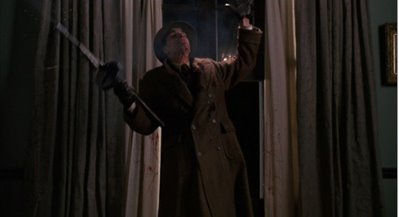
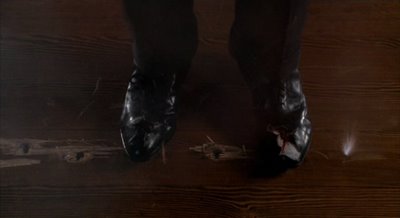

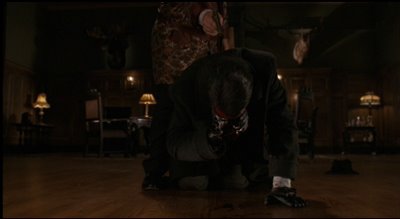
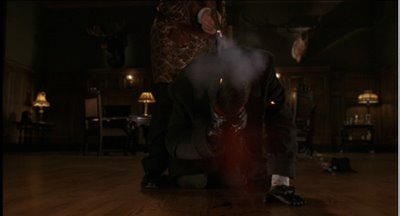

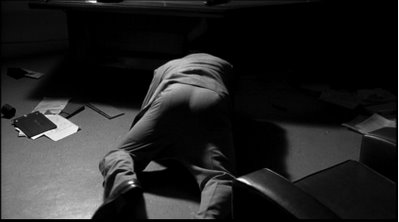
Both Hitchens and Brooks appear to have thought "Borat" was funny, but don't feel comfortable with that feeling. Laughing appears to have been a sin that requires some sort of confession. I have a feeling they would say the same things about Christopher Guest or Coen Bros. movies -- that they are about mocking, ridiculing, tearing down the characters so that the audience can feel superior. It does not seem to have occurred to either of them that it might be possible to laugh at -- even mock -- someone, while still feeling sympathy or even empathy. And that such feelings, as opposed to sheer derision, make the comedy even funnier.Going back to Kirkegaard, Emerson's argument implies that shadenfreude does not necessarily presume a metaphysical error. That is, contra Kirkegaard, shadenfreude can coexist with a unicity in which self and other are metaphysically one and the same. Watching someone else suffer, we identify with them and we laugh. This is possible because -- just like a person can laugh at their own pain when it has passed -- there's an ontological distance between us and, say, the mosquito bites on Barton Fink's face. The laughter is the same, the type of distance different.
Posted by
ndronen
at
7:24 PM
0
comments
![]()
Labels: movies
Now, in the mountains, far from the wet, ancient streets of Cordoba and Sevilla, the rain begins.
Posted by
ndronen
at
2:34 AM
0
comments
![]()
Evidence of Spain
Posted by
ndronen
at
11:05 AM
0
comments
![]()
Serious physical/electrical problems with the iBook stand between me and writing any more long posts or posting any more photos. I'm only able to write this because I'm holding it vertically, like I'm typing against the wall. Not the epitomy of ergonomic, to say the least.
Orgiva is up in the Sierra Nevadas. Nice little town. More later, perhaps after I get back to the USA and take the iBook into the Mac Shack in Boulder for repairs.
Ciao for now.
Posted by
ndronen
at
9:02 AM
0
comments
![]()
Last week I had a hunch that it wouldn't be worth my time to track down the Arabist professor at the University of Granada, the one that Besam, the Syrian student, said knew a lot about Ibn Al-Hatib and Sufism. I decided instead to get a hold of Pablo Beneito Arias, an Arabic specialist at the University of Sevilla.
I emailed Professor Beneito last week, told him that I had read one of his translations, and said I'd like to meet him to talk about Ibn Arabi. He responded with his phone number and said to call him this week.
I called him on Monday and he gave me approximate directions to his office. The University of Sevilla, at least the campus where he works, is set in an enormous building that used to be a tobacco factory. These days it's called the Fabrica de Tabaco Antigua. After tobacco was brought to Europe from America, King Phillip III of Spain tried to establish Sevilla as the tobacco capital of the world. Various punishments, such as execution, were in effect for Spaniards who violated the crown's monopoly. The factory produced cigars. Cigarettes were invented by beggars who used paper, not tobacco leaf, to roll something out of the used cigars they found on the street.
In the brief taxi ride from the hotel to the university, the driver gave me a whirlwind lecture about the tobacco factory and the history of the spread of tobacco in Europe. At least that's what I think he was talking about. ¿Entiendes? he asked. Mas o menos, I replied. I had to say Necesito ir ("I have to go") from the back seat of the cab because he kept on with his high-speed lecture even after I paid the fare.
One of the frustrating things about not being fluent in a language is that it's difficult to be polite when you want to. I try to be careful to begin certain sentences with lo siento ("I'm sorry" or, more literally, "I feel that") to establish some ground for patience between me and whomever I'm talking to. There are times, however, when it's difficult to remember the delicate aspects of a language and culture when you're struggling to say something simple. Even if you're not having the most sophisticated conversation, it's nice to have a good sense of fellow-feeling with people. Another thing that gets in the way of this, at least for me, is the fact that I tend to look away from whomever I'm talking to so as to concentrate on what I'm trying to say. It's bad body language, and it must be confusing and frustrating for them, too.
Back to the tobacco factory. The offices of the Arabic department are not all in one place, but two friendly professors guided me to Professor Beneito's office. The office was shared with perhaps a dozen other faculty members. It was a long room with a number of desks, each with its own computer, lined up along the wall facing the windows. There was only one man in the room. He was sitting at the very last desk in the row. It was Pablo. He greeted me warmly and, speaking very good English, suggested that we talk while we walk around the factory.
I didn't have any specific questions for him, so we spoke a little about Ibn Arabi, a little about Rumi, a little about Sufism, and a little about each other. He knows about existing Sufi groups. A number of years ago he visited Irina Tweedie in London, and he has read a few of Llewellyn Vaughn-Lee's books (e.g. Moshkel Gosha). He grew up near Murcia, Ibn Arabi's home town, which was his initial connection to him. I told him that when I read his translation of Contemplation of the Holy Mysteries, I found myself thinking of many of the paradoxes as facile, and that now that I've started reading William Chittick's (appropriately) dense summary of Ibn Arabi, the paradoxes seem much richer. He smiled when I said that. He said that, unlike Rumi or Attar, who are immediately accessible, Ibn Arabi takes some work; his subtlety reveals itself only after you know some of the terminology, context, and so on.
When I mentioned that I had considered seeking out a professor at the University of Granada, Pablo said that he knew that professor, and that the only work he did that I would be interested was from a long time ago and, moreover, his research since then has gone in a completely different direction. So my initial hunch was a good one.
Earlier today, I went to a teteria (tea house) near my hotel to write for a while. I sat down on a sofa in a corner room, laid back, and stared through the courtyard window at (I thought) nothing in particular. I started thinking that maybe there wasn't anyone else in Andalusia to talk to about Ibn Arabi. Right then, the thing I was staring at, a board on the wall above the archway of the entrance, came into focus. It read:
Hubo un tiempo en que yo rechazaba a mi projimo si su religion no era la mia. Ahora, mi corazon se ha convertido en el receptaculo de todas las formas: es el pradero de las gacelas y clausto de monjes cristianos, templo de idolos y Kaaba de peregrinos, tablas de la Ley y pliegos del Coran. Porque profeso la relgion del Amor y voy adonde quiera que vaya su cabalgadura, pues el Amor es mi credo y mi fe.I immediately recognized this as the text of the Arabic calligraphic print I bought in Granada from the Iraqi man, who recited his own English translation of it for me at the time. Roughly (with some expeditious help from Google Translate):
- Ibn Arabi (1165-1240)
There was a time in which I rejected a fellow if his religion were not mine. Now, my heart has become the receiver of all the forms: the grasslands of gazelles and cloisters of monks, temples of idols and travelers to the Kaaba, books of Law and pages of the Koran. Because I profess the religion of Love and go where it leads me, because Love is my creed and my faith.So I guess I'm done.
Posted by
ndronen
at
12:25 PM
0
comments
![]()
The Spanish word for umbrella is "paraguas," which -- if it's a contraction of "para" and "agua" -- literally means "for the waters." Even if that's not true, I don't own an umbrella. This puts me at a disadvantage in Cordova, because it's still raining.
You can't tell that it's raining. I used Photoshop to erase all of the raindrops from the photo. Actually, I kid. I didn't do anything to the photo. The reason you don't see any raindrops in the photo is that I used a relatively long shutter speed, which causes the light reflected from stationary objects to overwhelm any momentary light reflected off rain. People use this fact to eliminate people -- who tend to move around -- from photos of landmarks, buildings, and the like -- which tend to stay in place. The result is a photograph in which the desired subject is isolated.
In rain photos, lighting comes into play, too; when it's raining, more often than not there's not much direct sunlight. (There are, of course, those very cool moments when it's both raining and sunny.) In this photograph, if I had used a shorter shutter speed, the camera would not have received enough light. So there's a sweet spot with rain photos. You need a certain amount of light, so you have to keep the shutter open longer, but by doing so you fail to capture raindrops. (For the purposes of discussion, I'm leaving aside the role that aperature plays in this, but there's probably a huge hole in my understanding that, if filled, would make me approach this subject in a different way altogether, i.e. if I knew what I was talking about, I'd say it differently.)
If you add time to the equation, what happens? How do filmmakers shoot rain? Rain machines. Sometimes they flood the rain with light, which emphasizes the rain as a kind of diffuse, luminous presence. (Contrast that with shooting rain in the dark, where there's only the sound of rain hitting things.) They use lightning. They often hose down the streets before shooting a night scene in a city, but they do that because it's pretty to mirror the lights of the city on the ground (think Taxi Driver). Then there are hurricanes, where the rain is so intense that you can't miss it and -- of course -- you can't miss the havoc that the rain and the wind are causing.
Tonight I ate at Teberna Casa Pepe de la Juderìa, Calle Romero 1, Còrdova. The menu was friendly to foreigners (extranjeros), being written in Spanish, French, Italian, German, Portugese, English, and Japanese.
Dinner consisted of:
Posted by
ndronen
at
3:31 PM
0
comments
![]()
It's been raining since yesterday. Last night in Sevilla it started pouring. It let up a little on my drive to Cordoba this afternoon. It had been raining softly since I got to Cordova, and it started raining hard here about two hours ago.
It's eight o'clock, which means it's time to open my guide book and find a restaurant. I'll probably eat at ten tonight. In Spain, dinner happens after nine or so. The afternoon siesta makes the rest of the day happen late. Last night I was in a Flamenco bar that opens at midnight.
When I was in Granada I ate for nourishment, not for novelty. I ended up settling into a Doner Kebap groove. A gyro to Greeks is a kebap to Arabs, and there are a lot of little kebap tiendas in the Albaicin (or Albaycin), the old Arabic part of Granada. (I suppose to some a gyro isn't the most nourishing thing, but I think it actually has something from each of the food groups: grains (pita), vegetables (tomato and a kind of cole slaw), meat (lamb), and dairy (yoghurt). Did I forget fruit? That's the story of my life.)
After I left Granada, I discovered that Spain has some amazing food. In Ronda, at the Hotel Polo, I ate alone in the hotel restaurant. Not only was I solo at my table, but the only other person I saw was the waiter. (Fue tranquil.) It was perfect. He only had me to attend to, so he could take his time figuring out my Spanish. We had a conversation about the ontology (although I didn't use that term) of sherry in English, where sherry is a supertype, and the subtypes are the grades of dryness and sweetness. In Spain, however, there's no common supertype (unless the supertype is just "vino"); the driest "sherry" is called Jerez (after Jerez de la Frontera, a city in Andalusia) and the sweetest is called Màlaga (also a city in Andalusia).
Anyway, in Ronda I had lightly crusted ravioli stuffed with small eggs and ham, a seafood paella (a rice dish), a chocolate mousse, a cafe con leche (basically a small lattè), and a small glass of Màlaga.
Last night in Sevilla I had a booze-free beer and a small plate of olives. The entrèe was artichoke hearts stuffed with sautèed lamb, some kind of cheese, and a variety of mushrooms. To top it off I had cafe con leche and a hot chocolate cake with a mint sauce.
I'm going to have to do a lot of yoga to burn off these calories. Tubby me. Now where's that restaurant guide? All of this food talk has made me hungry.
Posted by
ndronen
at
12:09 PM
0
comments
![]()